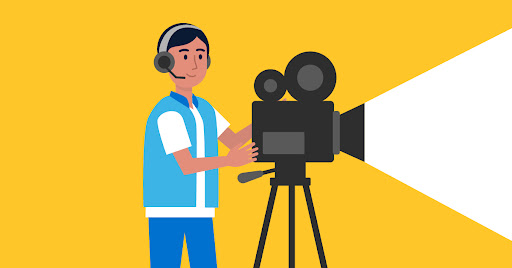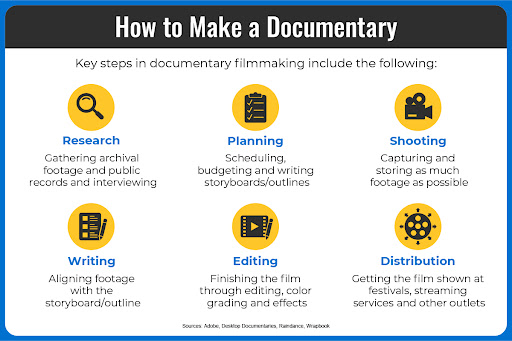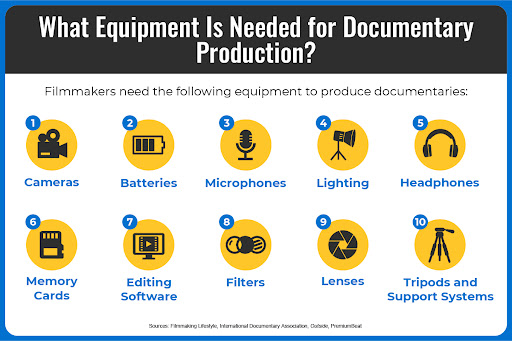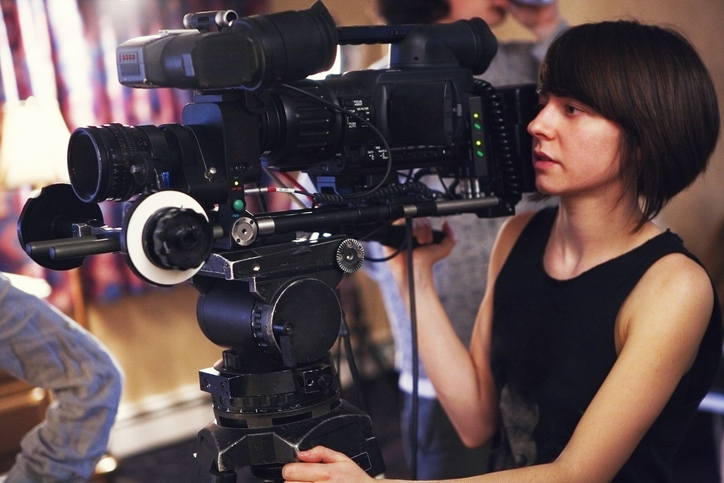How to Make a Documentary: A Step-by-Step Guide
Written by: Hilbert College • Feb 22, 2023

How to Make a Documentary: A Step-by-Step Guide ¶
Documentary films give insight into real-life events, people and issues that shape our world. Some illuminate moments in history, such as Ken Burns’s “ The Civil War”, which covers the conflict from the point of view of generals and foot soldiers, slaves and senators. Some document the lives of historical figures. In “ I Am Not Your Negro,” James Baldwin’s words, narrated by Samuel L. Jackson, provide an important commentary about the present. Others are intended to shape public opinion and drive social change, such as Michael Moore’s “ Bowling for Columbine,” which examines the epidemic of gun violence in America.
Documentaries have always been an important part of filmmaking, offering different perspectives and topics to explore. With streaming services such as Netflix, more viewers than ever have access to documentaries.
Learning how to make a documentary goes beyond exploring the latest film techniques and technologies. It requires an examination of the field and its history and key elements that make an impactful documentary.
Individuals interested in careers in the field should explore the step-by-step process of how to make a documentary.
What Is a Documentary? ¶
Documentaries are educational, informational or historical nonfiction films—that also entertain. Their subject matter varies widely, exploring topics in history, politics, the arts, science and beyond. Some focus on social issues, such as poverty, gender inequality or climate change. Others report on an event, such as a criminal investigation of a high-profile case.
In defining what a documentary is, it’s important to note that like all films, they tell stories that can entertain and inspire. They differ from feature films in that they’re grounded in factual material. Directors compile interviews, archival footage and other forms of audiovisual material. Sometimes, actors reenact events based on historical records, such as Revolutionary War battles or famous speeches.
Types of Documentaries ¶
Different types of documentary genres serve different purposes. One example is biographical films, which focus on a particular figure. While many biographical documentaries cover significant historical figures, they aren’t limited to the past; consider documentaries of present-day personalities, such as “ Harry & Meghan” and “ Neymar: The Perfect Chaos.”
Historical documentaries explore a historical period or event, such as the civil rights movement (“ Eyes on the Prize”) or anti-Vietnam War protests of the 1960s and 1970s (“ The War at Home”). They often include interviews with experts on the period, as well as archival footage and photographs. A key aim of these documentaries is to provide a greater understanding of how the past has shaped the present.
Beyond subject matter, different types of documentaries rely on various techniques. Here are six types that illustrate some of the ways that filmmakers can approach their subjects.
1. Poetic Documentaries ¶
A poetic documentary aims to evoke a mood and tone through thought-provoking and evocative visuals, rather than simply relating a narrative. This style of avant-garde documentary came to be in the 1920s, though it took until 2001 for the term “poetic documentary” to be coined. Examples of poetic documentaries are “ Skyscraper Symphony,” “ Fata Morgana” and “ Get Out of the Car.”
2. Expository Documentaries ¶
The expository documentary is one of the most widely used forms of documentary filmmaking. Expository documentaries aim to inform the audience on a specific topic or issue, often through a narrator or expert interviews. Examples of expository documentaries are “The Civil War,” “ The Blue Planet,” “ An Inconvenient Truth” and “ Our Planet.”
3. Observational Documentaries ¶
The observational documentary captures reality as it is. The aim of observational documentaries is to let the film speak for itself, allowing the audience to observe the natural flow of events and participants. Examples of observational documentaries are “ Salesman,” “ Grey Gardens” and “ Young Plato.”
4. Participatory Documentaries ¶
Participatory documentaries empower the film’s subjects, encouraging their active involvement in the creative process. This can help provide a more authentic representation of their experiences and give them a voice. Examples of participatory documentaries are “ Chronicle of a Summer,” “ The Wild Parrots of Telegraph Hill” and “ The Family of the Forest.”
5. Reflexive Documentaries ¶
Reflexive documentaries emphasize the filmmaker’s role in constructing the film and the audience’s role in watching it. These films promote transparency, with filmmakers often speaking directly to the audience and incorporating their own thoughts and feelings into the film. Examples of reflexive documentaries are “ The Act of Killing,” “ Nanook of the North” and “ Werner Herzog Eats His Shoe.”
6. Performative Documentaries ¶
Performative documentaries focus on the storyteller as much as the subject, with filmmakers proposing universal truths based on individual interpretations. Examples are “ Supersize Me,” “ Tongues Untied” and “ Aileen Wuornos: The Selling of a Serial Killer.”
History of Documentary Filmmaking ¶
Documentary filmmaking has its roots in the era of silent short films, including films by the Lumière brothers, Auguste and Louis Lumière, in the late 1800s and early 1900s. Initially, early filmmakers focused on showing everyday events, such as locomotives arriving, people dancing and animals playing. Soon, they began to add storylines and music to their creations, making them more engaging.
New techniques and experimentation ignited the evolution of cinema in the decades that followed. By the 1910s, filmmakers had become experts at controlling the perception of time and space in their films. Multiple camera angles and sets were used to give the impression of movement. Later, in 1920, the introduction of sound in movies, along with the rise of the studio system, revolutionized the industry. During this era, directors Robert Flaherty and John Grierson, considered fathers of documentary filmmaking, emerged.
Throughout the 20th century, documentary filmmakers continually pushed boundaries. In the 1930s and 1940s, filmmakers used the form to create propaganda. Leni Riefenstahl’s “ Triumph of the Will” used music, long-focus lenses and aerial photography to present the Nazis’ rise to power as heroic; Frank Capra’s series “ Why We Fight” used similar techniques to promote the Allies. Technical advancements such as handheld cameras allowed movie creation to be less intrusive and more adjustable.
The 1950s through the 1970s saw wider use of direct cinema, in which filmmakers strip down their tools and teams to the basics to document their subjects as accurately and unobtrusively as possible. This approach grants the camera a front row seat to events as they unfold.
The 1990s saw the rise of the digital revolution, including most recently, virtual production. Digital technology opened the door for independent filmmakers to produce high-caliber projects without the need for costly hardware. It also gave filmmakers the option to shoot and edit on computers, creating opportunities for them to be more imaginative and inventive with their storytelling. Digital technology also undergirds the expansion of video streaming services today, giving documentary filmmakers a chance to reach out to viewers from all over the world.
Documentary Film Resources ¶
Explore the history of documentary film with the following resources:
- Adobe, “How Documentaries Have Adapted to Online Platforms”: A brief historical overview of technology’s impact on documentary filmmaking.
- DocsOnline, “History of Documentary Film”: An illustrated guide to the history of documentary film.
- International Documentary Association, “‘Screening Reality’: A History of American Documentary Film”: A comprehensive historical survey on documentary film.
- PremiumBeat, “The 6 Types of Documentary Films”: A look at different types of documentaries with historical perspectives.
How to Make a Documentary in 6 Steps ¶
Documentary filmmaking is an art form that requires technical skill, organization and creativity. The three stages of film production are fundamental to the process: preproduction, production and postproduction.
- Preproduction: planning a film’s structure and content
- Production: capturing footage and recording sound
- Postproduction: editing footage and adding elements such as music and voiceover
While no single blueprint for creating a successful documentary exists, individuals interested in becoming documentary filmmakers should understand the following key steps:
Step 1: Research ¶
Detailed research sets the stage for a successful production. It can involve studying archival footage, public records, newspaper archives and academic research and conducting interviews. This step helps ensure that the film’s content is not only accurate and reliable but also engaging. Film research also involves investigating which production practices, techniques and genres work best for the film.
Step 2: Planning ¶
Planning is an essential part of preproduction. This step helps prevent conflicts during the production process. Planning includes scheduling, budgeting and storyboarding/outlining.
- Scheduling involves deciding the number of screenplay pages to shoot on a given day.
- Documentary budgeting outlines expected costs.
- Storyboarding involves writing an outline and a shot list to guide filmmaking.
Planning also considers legal and risk factors, such as obtaining permissions, insurance and - permits.
Step 3: Shooting ¶
The shooting process often involves shooting interviews, natural settings and live action. The main goal of the process is to get as much video footage as possible. Shooting cinematic scenes involves various elements, from recording equipment and cameras to actors and sites. As a precaution, having extra batteries and memory cards is important. The reason is that variables such as weather conditions and lighting decisions can hamper plans. A successful shoot includes the following strategies:
- Use enough lighting for sufficient exposure and to set the mood.
- Shoot multiple takes with different cameras.
- Use equipment that produces high-quality sound.
Step 4: Writing ¶
Writing helps align the captured footage with the original storyboard / shot list. The subject matter of the film and its participants play a crucial role in this process. Learning how to write a documentary requires a balance of structure and flexibility. A film’s story can evolve from the original plan based on the captured footage and new discoveries and developments. Writers often have the creative liberty to shape the story in a way that best showcases the subject matter and that highlights the perspectives of the interviewees.
Step 5: Editing ¶
Editing is essential for transforming raw footage into a professionally finished product. This means meticulous editing and color grading and incorporating visual effects. In this process, filmmakers may have to film additional footage to fill in narrative holes.
Recent advances in digital film editing technology allow filmmakers to bring their vision to life. For example, nonlinear editing and motion graphics software help blend different film components. Through the use of these tools, filmmakers can create a captivating experience.
Step 6: Distribution ¶
Distributing a finished film is a multifaceted process that involves elements of marketing and promotion to reach a wider audience. Here are some ways that filmmakers can promote their work:
- Showing at film festivals and entering contests: Film festivals and contests provide an opportunity for filmmakers to showcase their work to a diverse and engaged audience. They also offer networking opportunities and can help increase media exposure.
- Submitting to streaming services: Netflix, Amazon Prime Video and Hulu offer vast audience reach and offer the potential for ongoing income through subscription-based views. These streaming services can also help increase a film’s visibility and reach a wider audience.
- Applying for awards: Awards such as the Peabody Awards (open to online, streaming and television documentaries) can bring recognition and prestige to a film and its filmmakers. The application process can help increase a film’s visibility and attract attention from industry professionals.
- Showcasing in art theaters: Smaller theaters offer an intimate screening experience. The setting allows for meaningful audience engagement and discussion. Showcasing a film in these venues can also increase a film’s visibility and help build a loyal fan base.
- Hosting community and house party screenings: Community and house party screenings provide a unique opportunity for filmmakers to help increase a film’s visibility and create community engagement.
- Uploading a trailer to Vimeo or YouTube: Video-sharing platforms, such as Vimeo and YouTube, can help increase visibility and build buzz. This method also offers an opportunity to reach a wider online audience and drive traffic to other distribution methods.
- Sharing through email and social networks: Email and social networks, such as Facebook, Twitter and Instagram, can help reach a wider audience. These personal networks allow filmmakers to connect with potential fans and promote their films to highly targeted audiences.
- Selling to educational institutions: Selling a film to educational institutions, such as universities and libraries, can provide an additional source of income and increase a film’s visibility in academic circles.
- Distributing via DVD: DVDs provide a physical product for fans to buy and collect. They can also be sold through brick-and-mortar stores and online retailers, increasing a film’s reach.

Key steps in documentary filmmaking include the following, according to Adobe, Desktop Documentaries, Raindance and Wrapbook. Research: gathering archival footage and public records and interviewing. Planning: Scheduling, budgeting and writing storyboards/outlines. Shooting: Capturing and storing as much footage as possible. Writing: Aligning footage with the storyboard/outline. Editing: Finishing the film through editing, color grading and effects. Distribution: Getting the film shown at festivals, streaming services, and other outlets.
What Are the Five Elements of a Documentary? ¶
Effective documentaries are characterized by their ability to captivate and educate the audience. These films are well researched, engaging and thought provoking. Documentaries often push boundaries and challenge audiences to rethink their beliefs and perspectives. Highly acclaimed examples are the following:
- “ The Thin Blue Line” brought attention to the wrongful murder conviction of Randall Dale Adams.
- “ Blackfish” exposed the inhumane treatment of captive orcas in marine parks.
- “ Won’t You Be My Neighbor?” celebrated the life and legacy of Mr. Rogers in addressing children’s needs.
These films showcase the power of the genre to bring about change and spark important conversations. To do this, they employ the following key elements of a documentary: interviews, cutaways, archival footage, cinema verité and process footage.
1. Interviews ¶
Interviews are a trademark of documentaries. They serve as a way for filmmakers to gather information, perspectives and stories from individuals involved in or knowledgeable about the subject matter. Interviews for documentary filmmaking can be conducted in person or by phone or video call and are often edited together to create a coherent narrative.
2. Cutaways ¶
Cutaways are brief shots intercut with the main action, often serving to add context or provide visual variety. Cutaway shots can be taken of relevant locations, objects or actions that help enhance the story being told.
3. Chronicled/Archival Footage ¶
Chronicled or archival footage is previously recorded material used to support a documentary’s story. This can include news footage, home movies, photographs and other historical records. This type of footage can provide context, create a sense of history and help bring the story to life.
Cinema/Film Vérité ¶
Cinéma vérité (or film vérité) is a style of documentary filmmaking that prioritizes capturing real life as it unfolds. This style emphasizes candid moments and spontaneous events. It aims to create a sense of authenticity and objectivity. Filmmakers typically don’t intervene or manipulate the action while shooting.
Interaction/Process Footage ¶
Interaction or process footage captures the filmmaking process, such as constructing a set or preparing for an interview. It can help provide a deeper understanding of the subject matter and can help make abstract concepts more concrete. Process footage can include B-roll footage, which is supplemental or secondary video to primary footage.
Resources ¶
These resources provide information on some of the most successful and highly acclaimed documentaries in history.
- Esquire, “54 Documentaries That Will Change Your Life”: A select list of investigative films that provide life-enhancing perspectives.
- One37pm, “The 20 Best History Documentaries”: Examples of documentaries covering various historical topics.
- TimeOut, “The 65 Best Documentaries of All Time”: A ranking of documentaries throughout history covering wide-ranging subject matter.
- Vogue, “These Are the 78 Best Documentaries of All Time”: A timeline of highly acclaimed, historically important documentary films.
How Much Does It Cost to Make a Documentary? ¶
The expense of putting together a documentary can range dramatically depending on its production level, format and duration. The costs for making a documentary can range anywhere from a few thousand dollars to millions. A documentary film budget can include the following costs:
- Film equipment: essential tools required to capture and record footage
- Studio fees: rent for filming spaces
- Permits: authorization required to film in specific locations
- Production crews: staff needed to manage equipment and coordinate filming activities
- Catering: meals provided to the crew during filming
- Props: artifacts used to create believable sets
- Liability insurance: coverage for accidents or incidents during filming
- Transportation services: travel to filming locations
- Postproduction editing: process of refining raw footage into a final product
- Technology: software and hardware used for editing and postproduction
- Marketing expenses: promotional costs to attract an audience
- Distribution fees: cost of sharing the film with a wider audience
- Copyright fees: payment for the use of copyrighted materials
- Storage: keeping backup copies of the film, audio and other elements
How Much Money Can You Earn in Documentary Filmmaking? ¶
Members of the Directors Guild of America (DGA) are eligible for compensation of $15,544 a week minimum for documentaries, with minimum daily rates for television productions that range from $1,280 (non-prime time) to $1,921 (prime time).
Non-DGA filmmakers looking for funding can turn one of the many available grant opportunities, including the following:
- Alter-Cine Foundation
- National Endowment for the Humanities
- National Endowment for the Arts
- Corporation for Public Broadcasting
- Center for Independent Documentary
Documentary filmmakers can pursue many avenues to make money, including the following:
- Traditional media channels: selling works to television networks, streaming services and movie theaters for distribution
- Agency work and branded content: creating commercials, advertisements and promotional content for brands through advertising agencies or as independent contractors
- Nonprofits and cause-focused projects: creating documentaries, public service announcements and other content for nonprofit organizations, foundations and causes they support

Filmmakers need the following equipment to produce documentaries, according to Filmmaking Lifestyle, International Documentary Association, Outside and PremiumBeat: 1. Cameras. 2. Batteries. 3. Microphones. 4. Lighting. 5. Headphones. 6. Memory cards. 7. Editing software. 8. Filters. 9. Lenses. 10. Tripods and support systems.
What Equipment Is Needed for Documentary Production? ¶
Filmmaking has come a long way, with many modern technology and equipment options to enhance filmmaking processes and the final product. Making documentaries typically includes the use of a camera, a tripod, audio recording equipment, lighting equipment and editing software.
Here’s a list of equipment needed for documentary production.
Cameras ¶
Cameras serve as the primary device for capturing visual content. Different types of cameras include digital single-lens reflex (DSLR) cameras, mirrorless cameras, large-format cameras and motion picture cameras. Filmmakers also use GoPro cameras for action shots, drone cameras for aerial shots and 360-degree cameras for immersive experiences.
Batteries ¶
While studios have power outlets, shooting on location requires batteries to provide power to cameras, lights and other equipment. A sufficient number of fully charged batteries can help ensure smooth shooting schedules. Some film shoots may also require backup batteries in case of power failures or fluctuations.
Microphones ¶
Different types of microphones allow audio to be recorded along with video content. Microphones capture dialogue, sound effects and ambient sounds during production. Microphones are used on set during shooting to record the dialogue between actors, as well as during postproduction to capture voice-overs.
Lighting ¶
Lighting helps create a visual mood and atmosphere, influencing how the audience perceives a scene. It also creates depth, reveals details and helps define a film’s visual style.
Headphones ¶
Headphones are used for audio monitoring and playback. A primary example of how headphones are used on set includes sound engineers and boom operators monitoring the sound being recorded on set. Actors also use them to hear their own dialogue and the director’s cues. Directors use headphones to listen to the audio feed and give instructions during a shoot.
Other Important Equipment ¶
The following equipment also plays an important role on a documentary film set:
- Memory cards: for storing digital data in cameras, including raw footage
- Editing software: for postproduction in filmmaking, allowing content to be refined
- Filters: for modifying the light entering a camera lens, creating specific visual effects or correcting color balance
- Lenses: for changing the image quality, the depth of field and other visual elements
- Tripods and support systems: for stabilizing cameras, reducing camera shake and improving shot stability
- Monitors: for playback and review of footage to evaluate shots and make necessary adjustments
- Audio cables: for transmitting audio signals from microphones to sound recorders and other audio equipment
- Recorders: for capturing audio and video content, allowing filmmakers to preserve their work for postproduction
- External hard drives: for backup and storage of digital data, providing an additional layer of data protection
- Hand tools: for equipment maintenance and repair
- Camera bag: for protecting cameras and other equipment, especially during transport to different sets
- Boom pole: for holding microphones, allowing sound to be captured from specific points within a scene
- Shock mount: for isolating microphones from vibrations and improving audio quality
- Shoulder mount rig: for stabilizing and balancing cameras, improving the quality and comfort of handheld shots
- Digital data transfer method: for transferring large amounts of data between devices, such as raw footage and other important files
Start Learning How to Film a Documentary ¶
Working as a documentary filmmaker can be a fulfilling, rewarding career. Professionals who enjoy creative expression can thrive in this role and earn a competitive salary. Entering the field can be challenging, but data from the U.S. Bureau of Labor Statistics (BLS) shows that career opportunities are growing, with employment growth of 8% for producers and directors predicted between 2021 and 2031.
In learning how to film a documentary, gaining proficiency through structured learning, keeping up with the latest industry fads and strategies, and honing skills through imaginative experimentation are essential. A formal education program focused on teaching valuable filmmaking skills can also connect students with others in the domain, which can further support their efforts in reaching professional goals.
Infographic Sources:
Adobe, “How To Make A Documentary Film”
Desktop Documentaries, “Distributing Your Film”
Filmmaking Lifestyle, “14 Pieces of Filmmaking Gear You Really Need”
International Documentary Association, “Tools of the Trade: Documentary Makers Talk Gear”
Outside, “Documentary Film Gear: What You Need”
Premium Beat, “5 Essential Tools for Your Documentary Camera Package”
Raindance, “A Short Guide on Filming a Documentary That’s Worth the Watch”
Wrapbook, “How to Make a Documentary: A Guide to the Key Stages of Documentary Production”


